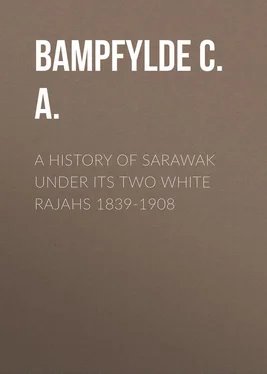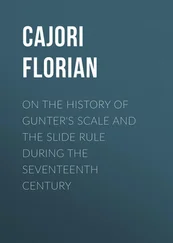C. Bampfylde - A History of Sarawak under Its Two White Rajahs 1839-1908
Здесь есть возможность читать онлайн «C. Bampfylde - A History of Sarawak under Its Two White Rajahs 1839-1908» — ознакомительный отрывок электронной книги совершенно бесплатно, а после прочтения отрывка купить полную версию. В некоторых случаях можно слушать аудио, скачать через торрент в формате fb2 и присутствует краткое содержание. ISBN: , Жанр: foreign_antique, foreign_prose, на английском языке. Описание произведения, (предисловие) а так же отзывы посетителей доступны на портале библиотеки ЛибКат.
- Название:A History of Sarawak under Its Two White Rajahs 1839-1908
- Автор:
- Жанр:
- Год:неизвестен
- ISBN:http://www.gutenberg.org/ebooks/52873
- Рейтинг книги:4 / 5. Голосов: 1
-
Избранное:Добавить в избранное
- Отзывы:
-
Ваша оценка:
- 80
- 1
- 2
- 3
- 4
- 5
A History of Sarawak under Its Two White Rajahs 1839-1908: краткое содержание, описание и аннотация
Предлагаем к чтению аннотацию, описание, краткое содержание или предисловие (зависит от того, что написал сам автор книги «A History of Sarawak under Its Two White Rajahs 1839-1908»). Если вы не нашли необходимую информацию о книге — напишите в комментариях, мы постараемся отыскать её.
A History of Sarawak under Its Two White Rajahs 1839-1908 — читать онлайн ознакомительный отрывок
Ниже представлен текст книги, разбитый по страницам. Система сохранения места последней прочитанной страницы, позволяет с удобством читать онлайн бесплатно книгу «A History of Sarawak under Its Two White Rajahs 1839-1908», без необходимости каждый раз заново искать на чём Вы остановились. Поставьте закладку, и сможете в любой момент перейти на страницу, на которой закончили чтение.
Интервал:
Закладка:
Sherif. 5 5 Pronounced by Malays Sherip, or Serip. Fem. Sheripa, Seripa. Sayid is another, though in the East less common title, assumed by descendants of the Prophet. Sir Richard Burton in his Pilgrimage says the former, men of the sword, the ruling and executive branch, are the descendants of El Husayn, the Prophet's grandson; and the latter, men of the pen, religion, and politics, are descended from the Prophet's eldest grandson, El Hasan. Siti is the female title.
– An Arab title meaning noble. A title assumed by half-bred Arabs claiming descent from Muhammad. These men also take the exalted Malay title of Tunku or Tungku 6 6 A corruption of Tuan-ku (Tuan aku), my Lord, as it is often so pronounced.
by which princes of the royal blood are alone addressed, but more especially the Sultan.
Haji. – One who has made the pilgrimage to Mecca.
Tuan. – Master, Sir, Lord, Mistress, Lady. Tuan Besar – High Lord. Tuan Muda – Young Lord.
Nakoda. – Shipmaster, merchant.
Pengulu. – Headman. A title given to Dayak district chiefs.
Inchi. – Mister – a lower title than Tuan. A title foreign to Sarawak, and in that country only assumed by foreign Malays.
Abang. – Lit. elder brother. Datu's sons are styled Abang, and also Malay Government chiefs below the rank of Datu.
Laksamana. – An Admiral.
Imaum. – High Priest.
Hakim. – A Judge: lit. a learned man.
Awang. – A title sometimes given to the sons of Pangirans.
Dayang or Dang. – Lady of rank. A title given to daughters of Datus and Abangs.
Wan. – Another title given to Sherifs, but more generally to their sons. It is probably derived from the Arabic word Awan, meaning a helper or sustainer of Muhammad.
The following Malay geographical terms should also be noted: —
Bukit, a hill.
Danau, a lake.
Gunong, a mountain.
Pulau, an island.
Sungi, a river.
Tanjong, a cape.
Kampong, a village, or subdivision of a town, a parish.
CHAPTER I
BORNEO
Next to Australia and New Guinea, Borneo 7 7 The name Borneo is a corruption of Burni, itself a corruption of Beruni or Bruni, the capital of that ancient but now decayed Sultanate bearing the same name, and of which Sarawak, and a great part of British North Borneo, once formed parts. It was the first place in Borneo with which the Spanish and Portuguese had any dealings, and in their old chronicles it is referred to as Burni, and Borneo subsequently became the distinguishing name of the whole island to Europeans. The natives themselves have none, except perhaps the doubtful one of Pulau Ka-lamanta-an, the island of raw sago, so named in recent times by the merchants and traders of the Straits Settlements as being the island from which that commodity was brought, and in those settlements it has since become the native name for Borneo. But in Sarawak this name is known to the Malays alone, and in other parts of Borneo, perhaps only a few have heard of it. In fact, it is applicable to Sarawak only, for in former days sago was exported to the Straits solely from that country, and the trade was carried on by Sarawak Malays, first with Penang and subsequently with Singapore. An old English map of about 1700 gives to the town of Bruni, as well as to the whole island, the name of Borneo. Mercator (1595) also gives Borneo to both. Bruni is variously spelt Brunai, Brunei, Bruné, Borneo, Borney, Bornei, Porne, and Burni by old writers; all corruptions of Bruni. The Sanskrit word Bhurni, meaning land or country, has been suggested as the origin of the name.
is the largest island in the world; it is larger than the whole of France. It sits astride on the equator, that divides it nearly, but not wholly, in two; the larger portion being to the north of the Line.
The belt of islands, Sumatra, Java, and the chain to Timor and the Sarwatty group, represents a line of weakness in the crust of the earth, due to volcanic action, which still makes itself felt there. But the axis of elevation of Borneo is almost at right angles to this line, and in it are no active vents, and if there be extinct volcanoes, these are in the extreme north only. In Sarawak there are several hot springs, the water of which is impregnated with sulphuretted hydrogen. The island owes its origin, as far as we can judge, to a great upheaval of plutonic rock that has lifted aloft and shivered the overlying beds, but the granite does not come everywhere to the surface. Something analogous may be seen in Exmoor, where the superincumbent clay-slate has been heaved up and strained, but the granite nowhere shows save in Lundy Isle, where the superposed strata have been swept away, leaving the granite exposed.
Borneo is about 850 miles in length and 600 in breadth, and contains an area of 286,000 square miles. The centre of Borneo is occupied by broken hilly highland, with isolated mountains, of which the finest is the granite peak of Kina Balu (13,700 feet). Hills come down in places to the sea, as in the south of Sarawak, where they attain a height of from 2000 to over 5000 feet, and die into the sea at Cape Datu. The plains, chiefly swamps, are composed of the wash of the mountains, overlaid by vegetable mould, and these fringe the coast, extending inland from ten to thirty miles, with here and there isolated humps of hill standing up out of them.
The island is probably the best watered in the world. On every side are numerous rivers, mainly rising in the central highlands, at first dancing down the mountain ledges in cascades, then, forming dangerous rapids, enter the plain, and there swelled by affluents and widening out advance with no strong current to the sea. Owing to the width of the river-mouths, and to the configuration of the coast, some of them, as the Batang Lupar, the Sadong, and Saribas, have tidal bores, as is the case with our River Severn, that run up as many as seventy miles into the interior, and most have deposited troublesome bars at their mouths, and have embouchures clogged by shoals. To the slight fall is largely due the remarkable way in which several of these rivers descend into the ocean through plural mouths, thus forming a network of lateral waterways, called Loba and Trusan, whereby they mix and mingle with other rivers, and, very much like the Rhine after entering Holland, lose their identity and are frittered away in many channels. The Rejang, for instance, finds issue through five mouths, and the land between the Rejang and Igan entrances, which meet at Sibu, the apex of the delta, is a vast unbroken swamp, 1200 square miles in area. The same phenomenon is noticed in the Sarawak river, and in the Limbang to a smaller degree.
The rainfall in Borneo is so great, the rainy season lasting from October to April, 8 8 See page 34 .
that the rivers are very numerous and copious, rolling down large volumes of water. Severe droughts are, however, not uncommon during the fine season of the S.W. monsoon.
Between Kuching and Bruni are the Sadong, Batang Lupar, Saribas, Kalaka, Rejang, Bintulu, and the Baram rivers, all available as waterways for trade with the interior. For fifteen miles only from its mouth is the Batang Lupar navigable by steamers, above that, though a fine broad river, it is obstructed by dangerous shoals. The Rejang is navigable by steamers for 170 miles, nearly as far as the first rapids. This noble river descends many stages by as many plunges from terraces. Between the rapids the river is deep, sluggish and broad for many miles. Boats that can be hauled up past the rapids can ascend a distance of 650 miles from the mouth. The Baram river is navigable by steamers for some twenty miles above Claude Town, that is, eighty miles from the mouth, but owing to the exposed position of the bar and to the heavy seas breaking over it, and also to the silting up of the mouth during the N.E. monsoon, only very small craft can then enter, but during the S.W. monsoon it can be entered by steamers of light draught.
Читать дальшеИнтервал:
Закладка:
Похожие книги на «A History of Sarawak under Its Two White Rajahs 1839-1908»
Представляем Вашему вниманию похожие книги на «A History of Sarawak under Its Two White Rajahs 1839-1908» списком для выбора. Мы отобрали схожую по названию и смыслу литературу в надежде предоставить читателям больше вариантов отыскать новые, интересные, ещё непрочитанные произведения.
Обсуждение, отзывы о книге «A History of Sarawak under Its Two White Rajahs 1839-1908» и просто собственные мнения читателей. Оставьте ваши комментарии, напишите, что Вы думаете о произведении, его смысле или главных героях. Укажите что конкретно понравилось, а что нет, и почему Вы так считаете.












